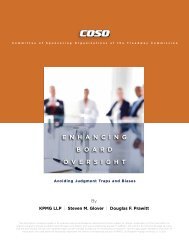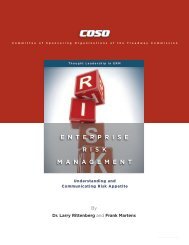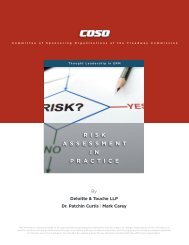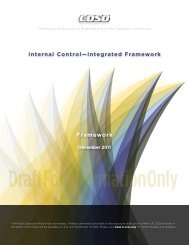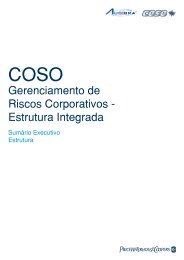Embracing Enterprise Risk Management: Practical - Coso
Embracing Enterprise Risk Management: Practical - Coso
Embracing Enterprise Risk Management: Practical - Coso
You also want an ePaper? Increase the reach of your titles
YUMPU automatically turns print PDFs into web optimized ePapers that Google loves.
Thought Leadership in ERM | <strong>Embracing</strong> <strong>Enterprise</strong> <strong>Risk</strong> <strong>Management</strong>: <strong>Practical</strong> Approaches for Getting Started | 5<br />
organization’s business strategy and its components and<br />
then identifying the principal risks that would impede its<br />
ability to achieve its strategic objectives. An alternative is to<br />
discuss the strategies and risks of each of its major business<br />
units. To aid in these discussions, some organizations<br />
prepare a list of major risk categories, such as operational,<br />
financial, legal, market and then discuss exposures to that<br />
risk category for the business overall or each significant<br />
business unit.<br />
It is often simplest and most effective for an organization to<br />
conduct this initial, top-down risk assessment with a handful<br />
of key business-unit leaders and members of the “C-suite.”<br />
More individuals across and further within the organization<br />
can be added later as the risk assessment process<br />
matures. This data gathering could be accomplished<br />
through interviews, surveys, facilitated discussion groups<br />
or committee meetings. (See Appendix D to this paper for<br />
some examples of questions to consider for this initial risk<br />
assessment.)<br />
The organization should then consider prioritizing or ranking<br />
the risks identified. This step could be accomplished by a<br />
simple ranking of the perceived level of inherent risk or by<br />
a more detailed assessment of the probability and impact<br />
of each risk. Consider using a basic scale of high, medium<br />
and low for each inherent risk as a starting point rather<br />
than quantification or modeling. Again, during this initial<br />
assessment, many organizations find good discussion and<br />
simple classifications helpful.<br />
As a result of some of the large and unexpected risks that<br />
have manifested themselves lately, some organizations are<br />
now expanding their impact and probability assessments to<br />
include other factors. Examples of these new factors include<br />
assessing the velocity of a risk or the level of preparedness<br />
of the organization for that risk. For an example of an<br />
expanded risk assessment, see the Example Strategic <strong>Risk</strong><br />
Profile following Step 6.<br />
Whatever specific approach is taken, the information<br />
gathered should be compiled into an initial list with a<br />
manageable number of risks or potential risk events. As<br />
the organization matures its ERM processes, it can probe<br />
into finer levels of detail on other risks or, with enhanced<br />
knowledge of risk management activities, evolve its risk<br />
assessment from inherent risks to residual risks. Keep in<br />
mind, however, that focusing on too much detail or too<br />
many risks in the early stages of ERM adoption can impede<br />
progress on the broader ERM effort.<br />
The organization also needs to assess its risk responses<br />
related to identified risks and develop action plans to<br />
address any gaps that are beyond those acceptable.<br />
Typically, action plans stemming from the initial risk<br />
assessment would identify gaps in the existing risk<br />
management processes related to the risks identified and<br />
detail specific ways to address those gaps.<br />
The initial risk assessment exercise is also a time to initiate<br />
discussions about the organization’s risk appetite relative<br />
to the risks identified. Some executives find it difficult to<br />
articulate, much less discuss, their organization’s risk appetite.<br />
To overcome this challenge, consider focusing initially on<br />
qualitative or narrative descriptions of the risk appetite, (e.g.<br />
the organization may have zero tolerance for anything related<br />
to customer or employee safety). <strong>Management</strong> can facilitate<br />
the discussion of the risk appetite by identifying types of<br />
activities or products that they will or will not undertake<br />
because of the perceived risks. Alternatively, they may<br />
discuss how risk aggressive or conservative they want to be<br />
compared to their peers or competitors.<br />
Step 5.<br />
inventory the Existing <strong>Risk</strong> <strong>Management</strong> Practices<br />
During the risk assessment process, the organization should<br />
also be taking an inventory of its current risk management<br />
practices to determine areas of strength to build upon and<br />
areas of weakness to address. This inventory becomes<br />
valuable information for management to assist in enhancing<br />
the risk management processes.<br />
First, it enables the organization to identify gaps in its current<br />
risk management processes relative to its most important<br />
and significant risks as they are identified. Oftentimes risk<br />
management activities are focused on existing operations<br />
and compliance risks, as opposed to significant external,<br />
emerging or strategic risks. As new risks are identified in<br />
the risk assessment process, the knowledge gained from<br />
a comprehensive inventory of existing risk management<br />
activities will help the organization assess the connections<br />
between existing risk management processes and the<br />
most critical enterprise level risks so that management can<br />
determine if there are any gaps in how they are managing<br />
the most important risks. Further, it assists the organization<br />
in mapping risks to underlying objectives.<br />
Second, the inventory forms a baseline for the organization<br />
as it continues to develop and enhance its ERM processes.<br />
It helps management demonstrate progress and the benefits<br />
of ERM by serving as a point of comparison as the processes<br />
mature.<br />
w w w . c o s o . o r g




